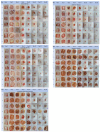In Vivo Evaluation of Wound Healing Efficacy of Gel-Based Dressings Loaded with Pycnogenol™ and Ceratothoa oestroides Extracts
- PMID: 38667652
- PMCID: PMC11048808
- DOI: 10.3390/gels10040233
In Vivo Evaluation of Wound Healing Efficacy of Gel-Based Dressings Loaded with Pycnogenol™ and Ceratothoa oestroides Extracts
Abstract
Ceratothoa oestroides and French maritime pine bark (Pycnogenol™) extracts are considered promising therapeutic agents in wound healing. This study explores the healing efficacy of composite dressings containing these extracts, aiming to enhance their stability and effectiveness, utilizing a low-temperature vacuum method for producing Sodium Alginate-Maltodextrin gel dressings. Surgical wounds were inflicted on SKH-hr2 hairless mice. Dressings were loaded with Pycnogenol™ and/or C. oestroides extracts and assessed for their efficacy. Wound healing was primarily evaluated by clinical and histopathological evaluation and secondarily by Antera 3D camera and biophysical measurements. Dressings were stable and did not compromise the therapeutic properties of C. oestroides extract. All interventions were compared to the C. oestroides ointment as a reference product. Most of the wounds treated with the reference formulation and the C. oestrodes dressing had already closed by the 15th day, with histological scores of 7 and 6.5, respectively. In contrast, wounds treated with Pycnogenol™, either alone or in combination with C. oestroides, did not close by the end of the experiment (16th day), with histological scores reaching 15 in both cases. Furthermore, treatment with 5% Pycnogenol™ dressing appeared to induce skin thickening and increase body temperature. The study underscores the wound healing potential of C. oestroides extracts and highlights the need for further research to optimize Pycnogenol™ dosing in topical applications.
Keywords: Ceratothoa oestroides; Pinus pinaster; Pycnogenol™; composite wound dressings; gel dressings; wound healing.
Conflict of interest statement
The authors declare that there are no conflicts of interest.
Figures













References
-
- Senni K., Pereira J., Gueniche F., Delbarre-Ladrat C., Sinquin C., Ratiskol J., Godeau G., Fischer A.-M., Helley D., Colliec-Jouault S. Marine polysaccharides: A source of bioactive molecules for cell therapy and tissue engineering. Mar. Drugs. 2011;9:1664–1681. doi: 10.3390/md9091664. - DOI - PMC - PubMed
-
- Fan B., Dun S.H., Gu J.Q., Guo Y., Ikuyama S. Pycnogenol Attenuates the Release of Proinflammatory Cytokines and Expression of Perilipin 2 in Lipopolysaccharide-Stimulated Microglia in Part via Inhibition of NF-κB and AP-1 Activation. PLoS ONE. 2015;10:e0137837. doi: 10.1371/journal.pone.0137837. - DOI - PMC - PubMed
LinkOut - more resources
Full Text Sources

